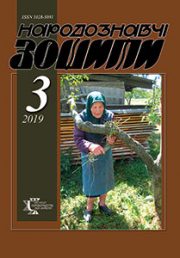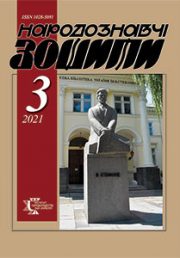The Ethnology Notebooks. 2021. № 5 (161), 1167—1173
UDK 94:37.013.43]:008-047.86(477)”1920/1940″
DOI https://doi.org/10.15407/nz2021.05.1167
KONDRATIUK Olena
- ORCID ID: https://orcid.org/0000-0002-5996-1768
- Сandidate of History (Ph. D),
- Head of Department of Ethnology,
- State Scientific Center of Protection of Cultural Heritage
- from Technological Disasters,
- Peremogy ave., 56, Kyiv, 03057, Kyiv, Ukraine,
- Contacts: e-mail: lenvin2007@gmail.com
BATYRYEVA Iryna
- ORCID ID: https://orcid.org/0000-0002-6876-8978
- Сandidate of History (Ph. D),
- 18/38, Kropyvnytskoho st., 21050, Vinnytsia, Ukrainе,
- First Deputy General Director
- National Museum of the Holodomor Genocide,
- Contacts: e-mail: angelbat0@gmail.com
Abstract. The research is relevant as it considers the impact of soviet teachers onto the process of traditional Ukrainian lifestyle destruction in 1920ths—1940ths.
The subject and the source base of the research are oral historical testimonies of Ukrainians, archival documents, illustrations (placates), periodicals of the mentioned period.
The goals of the research are: to define the methods and directions of new soviet teachers used to impact onto children’s education in the course of communistic propaganda; to analyze the pressure methods they used for certain group of children (manipulations, intimidations, persecutions and prosecutions); to show how starting from the 1930s, communist totalitarian regime attracted village teachers of Ukraine to «brigades of activists» and how they became both eyewitnesses and participants of forced collectivization and dekulakization (rozkurkulennia), mass repressions, terror, and organizing the crime of the Holodomor genocide against Ukrainian nation in 1932—1933; to analyze the reasons why teachers became active executants of anti-Ukrainian policy of Soviet government which caused collective trauma of the nation; to reveal the changes of traditional family lifestyle, relations between members of Ukrainian family, relationships inside the rural community and deformation of traditional Ukrainian culture.
The methods of structural typology, historical comparison, cross-disciplinary and field researches were used for the goals accomplishment.
Keywords: Soviet teacher, traditional culture, еveryday life, deformation, collective trauma, communist totalitarian regime, the Holodomor genocide.
Received 30.07.2021
REFERENCES
- Assmann, J., & Czaplicka, J. (1995). Collective Memory and Cultural Identity. New German Critique. Special Issue: Cultural History/Cultural Studies, 65, 125—133.
- Nora, P. (2005). World celebration of memory. Emergency ration (Vol. 2—3). Retrieved from: http://magazines.russ.ru/nz/2005/2/nora22.html [in Russian].
- Gorobets, S., & Butko, S. (2018). Notes on the Holodomor. About teachers. Chernihiv format. Retrieved from: https://format.cn.ua/news/notatki_pro_golodomor_pro_vchiteliv/2018-12-28-5613 [in Ukrainian].
- An international research and practice conference is «Problem of choice of екзистенційного during Holodomor — genocide». Retrieved from: https://holodomormuseum.org.ua/conferencia/mizhnarodna-naukovo-praktychna-konferentsiia-problema-ekzystentsijnoho-vyboru-pid-chas-holodomoru-henotsydu/ [in Ukrainian].
- State Archives of Odessa region. F. R. 233. Op. 1. Case 15.
- Avdiyenko, M. (1927). Public education in Ukraine. Kharkiv [in Ukrainian].
- Kulchytskyi, S.V. (Ed.) (2012). Ukrainian Soviet society in the 30’s of XX century: essays on everyday life. Collective monograph. Kyiv [in Ukrainian].
- Yakubova, L. (2011). Everyday life of ethnic minorities of Soviet Ukraine in the interwar period. Kyiv [in Ukrainian].
- (2005). Decree of the Provisional Workers and Peasants Government of Ukraine «On the Separation of the Church from the State and the School from the Church» of January 19, 1919. From the archives of the VUCHK-GPU-NKVD-KGB (Vol. 1/2, pp. 41—42). Kyiv [in Ukrainian].
- State Archives of Khmelnytsky region. F. R. 337. Op. 1. Case 87 [in Ukrainian].
- Stasiuk, O. (2014). Today’s generations of Ukrainians overcome the genetic fear caused by the Holodomor. Censor.net. Retrieved from: https://censor.net.ua/resonance/313037/sogodnshn_pokolnnya_ukrantsv_dolayut_genetichniyi_strah_sprichineniyi_golodomorom_storik_olesya_stasyuk [in Ukrainian].
- Myronov, M. (1932). The first pioneers. From the memories of the first years of the Committee. Kharkiv; Odessa [in Ukrainian].
- Kondratyuk, O. (2016). Materials recorded in the village Stepky, Ovruch district, Zhytomyr region. Audio archive of the State Scientific Center for the Protection of Cultural Heritage from Man-Made Disasters (hereinafter — AA DNCZKSTK). F. Ovruch-(VIII—IX)-2016. Unit. zb. O. Kondratyuk, AF-D2.S.1/ 06 [in Ukrainian].
- Kondratyuk, O. (2013). Materials recorded in the village Yarynivka Bereznivskyi district Rivne region. AA DNCZKSTK. F. Berezne-(VII—VIII)-2013. Od. zb. O. Kondratyuk. AF-D3.S.2/08 [in Ukrainian].
- (1929). The content of pioneering work in the USSR. Lecture XV: «Protection of children’s rights and work with unorganized children». Kharkiv [in Ukrainian].
- Kondratyuk, O. (2017). Materials recorded in the village Hrаbiv of Ripky district of Chernihiv region. AA DNTSZKSTK. F. Ripki-(VII—VIII)-2017. Od. zb. O. Kondratyuk. AF-D2.S.2/08 [in Ukrainian].
- Borysenko, V. (2011). Such a life… The culture of everyday life in Ukraine of Chornobyl Polissya (according to the materials of the ethnographic expedition in 1994). Kyiv: Stylos [in Ukrainian].
- Kutelmakh, K. (1996). Calendar rituals. Materials of research works of 1995—1996 on the topic «Comprehensive historical and ethnographic research and fixation of material and spiritual culture of radiation-contaminated zones of Zhytomyr Polissya» (Part 1, vol. 7). Lviv [in Ukrainian].
- Kondratyuk, O. (2017). Materials recorded in the village Hrаbiv of Ripky district of Chernihiv region. AA DNTSZKSTK. F. Ripki-(VII—VIII)-2017. Od. zb. O. Kondratyuk. AF-D2.S.2/20 [in Ukrainian].
- Balushok, V. (1997). Traditional youth groups in the north of Central Polissya. Polissya of Ukraine: materials of historical and ethnographic research (Vol. 2, pp. 319—324). Lviv [in Ukrainian].
- Stasiuk, O. (2008). Genocide of Ukrainians: deformation of folk culture. Kyiv: Stylos [in Ukrainian].
- Manuscript Archive of the Institute of Art History, Folklore and Ethnology of the National Academy of Sciences of Ukraine. F. 30. Sergiev M.K. [in Ukrainian].
- Tkachenko, B. (2008). Under the black brand: documents, facts, memories. Historical intelligence about the genocide in Ukraine, and in particular in the Sumy region, in 1932—1933, is sealed by the highest judge — human memory. Sumy [in Ukrainian].
- Kulchytskyi, S. (Ed.). (1992). Collectivization and famine in Ukraine, 1929—1933: a collection of documents and materials. Kyiv: Naukova Dumka [in Ukrainian].






